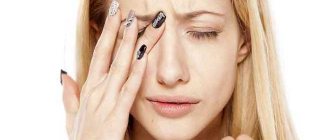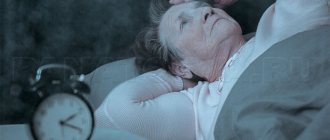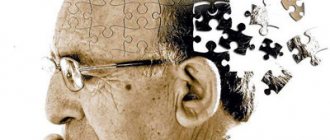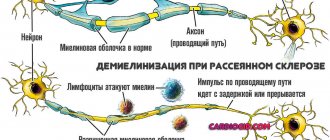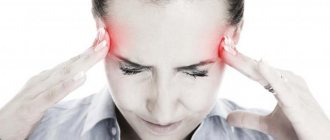Causes
For a healthy person, fear of light, especially sunlight, is an atypical condition. Therefore, if children or adults clearly show strong intolerance to bright lighting and are bothered by accompanying pathological symptoms, it is possible that an ophthalmological or other disease is developing in the body, requiring immediate treatment.
Photosensitivity is clearly manifested in the following diseases:
- conjunctivitis;
- keratitis;
- blepharitis;
- uveitis;
- glaucoma;
- retinal detachment;
- deformation of the cornea or lens;
- eyeball injury.
A painful reaction to bright light is a symptom of meningitis.
Photosensitive people are patients with meningitis, as well as those who suffer from diseases affecting the central nervous system. Often a person begins to be afraid of light during VSD, especially if the attack happened suddenly, under the scorching sun and in a place with a large crowd of people. Men and women whose brain is affected by a malignant tumor are sensitive to the bright sun.
Dry, red eyes and photophobia often occur in people whose work involves visual and mental stress. It has been found that adults suffering from depression or chronic fatigue react negatively to light. Photophobia in children often occurs with congenital abnormalities of the visual organs, central nervous system and brain, thyroid disease, and oculomotor nerve palsy. Therefore, if bright light brings significant discomfort, you should not postpone a visit to the ophthalmologist.
Associated symptoms
For photosensitive people, when outdoors or in a bright room, their eyes immediately become watery and sore. This reaction forces the adult to squint, close his eyes, and hide in a dark place as quickly as possible. In addition, the patient complains of the following accompanying symptoms:
Nausea and vomiting may occur after exposure to the sun.
- headache;
- dizziness, vomiting;
- increase in pupil size;
- feeling of the presence of a foreign body under the eyelid;
- deterioration of visual function;
- unclear outline of the object in question.
Increased sensitivity to light, high temperature, at which there is a severe headache and the urge to vomit, a wet cough, indicate that a viral infection has entered the body and the progression of acute respiratory infections or acute respiratory viral infections. If it is painful for a person to blink, the eyelids become swollen, and pus is released from the conjunctiva, the cause of this condition may be damage to the mucous membrane of the eye with conjunctivitis, blepharitis or other ophthalmological pathologies.
Diagnostics
If a baby, an older child or an adult has eyes that are too sensitive to light, or becomes ill in bright light, you need to make an appointment with an ophthalmologist and undergo a series of diagnostic measures, thanks to which it will be possible to find out the causes of photophobia and establish an accurate diagnosis. The examination includes the following methods:
Pachymetry is necessary to accurately determine the disease.
- physical examination of the eye, eyelids, conjunctiva;
- ophthalmoscopy;
- biomicroscopy;
- pachymetry;
- tonometry;
- perimetry;
- eye examination using a slit lamp;
- Ultrasound of the eyes;
- CT or MRI of the brain;
- electroencephalography.
If increased photosensitivity is accompanied by other internal pathologies, additional consultation with the following highly specialized specialists will be required:
- neurologist;
- endocrinologist;
- infectious disease specialist;
- cardiologist;
- oncologist.
What treatment is prescribed?
Effective drugs
If a person develops photophobia after a severe bruise, injury or burn to the eyes, the mucous membrane must be treated with antiseptic agents, a sterile bandage applied and the victim urgently taken to the hospital.
To relieve discomfort, the doctor will select the necessary drug.
It is important to treat increased eye sensitivity to light in a comprehensive manner, so first of all, medications are prescribed that eliminate the root cause of the pathology. To prevent it from being painful to look at on the street or in a bright room, the doctor will prescribe special eye drops. If a person reacts inadequately to light due to damage to the organs of vision by a bacterial infection, bactericidal ophthalmic drugs are prescribed, for example, such as: Traditional medicine will help reduce pain.
You can try to treat photosensitivity of the eyes using alternative medicine methods, after consulting with your doctor. Medicines prepared at home are not able to get rid of the main cause of photophobia, but with their help they will be able to remove unpleasant symptoms, inflammation, redness, burning and itching. The following home remedies have worked well:
- Anti-inflammatory herbal infusion. Pour 1 tsp into the teapot. calendula and chamomile flowers, pour 300 ml of boiling water over everything. Leave the product for 40 minutes, pour a little into a clean container, moisten gauze or cotton wool in it and wipe your eyes 3-4 times a day. You can put the infusion in your eyes, this will help cure the disease faster.
- Drops on silver water. Boil 500 ml of water, cool and lower the silver item into it. Cover the container with the liquid with a napkin and set aside for 5-7 days. When the product is ready, use it in the form of eye drops daily in the morning, afternoon and evening before bed. To enhance the effect, it is recommended to add honey and aloe juice in a ratio of 5:1:1.
Compresses based on sea buckthorn oil, which are recommended to be applied to the eyelids for half an hour before bedtime, help strengthen visual function and improve vision.
Photophobia (photophobia) in children is manifested by strong sensitivity of the eyes to daylight or artificial light. When light hits the retina of the eyes, an unpleasant burning sensation occurs, which leads to a defensive reaction - frequent blinking and squinting. This is a normal reaction of any person when leaving a dark room into the light, or when the power is suddenly turned on. But if a child constantly experiences discomfort in daylight, then you should be wary.
Reasons may be:
- Psychological stress, stress, fatigue, lack of sleep;
- Pathologies of acquired and congenital nature;
- Taking medications, often provoked by antibiotics - doxycycline, tetracycline and diuretics - furosemide;
- Heavy strain on the eyes when a child sits at the computer for a long time and often;
- Wearing clothes that are incorrectly selected;
- Tumors, traumatic eye injuries, foreign bodies.
The primary cause of photophobia will be congenital. A child with this pathology has no or low amounts of melanin - the disease is called albinism. Photophobia can develop with various eye diseases - iritis.
If a child has acrodynia, the symptoms of photophobia will be pronounced. Acrodynia is a disease of the nervous system in which the following symptoms appear: the feet and hands turn pink and become sticky due to profuse sweating. The child becomes sensitive to bright light. The next disease in which we observe symptoms of photophobia is endocrine ophthalmopathy. Autoimmune type disease.
The causes of the disease are pathologies of the thyroid gland. The child is observed, he complains of an imaginary foreign body that interferes with looking, he is afraid to look at the light.
In case of injury or previous infectious diseases, paralysis of the motor nerve may develop. The symptoms of this disease are easy to recognize: the upper eyelid is drooping and the eye looks to the side, while the pupil is dilated and does not react to light, so a reaction to light occurs.
If photophobia is a concern on both sides, then we can state the fact of the cause of common diseases, for example, measles or, moreover, with these diseases the temperature rises. If there are no other visible symptoms, then be wary, because in children such diseases can begin with these symptoms.
Conjunctivitis occurs frequently in children. The disease can be viral, bacterial or allergic.
Itching, burning, tearing, discharge from the eyes and photophobia are symptoms of the disease. With conjunctivitis, the body temperature may not rise, but more often, if this is a viral complication, then the temperature will be. In some cases, photophobia occurs because the child has been looking at the sun for a long time; bright sunlight affects the membranes of the eyes, resulting in this disease. There is snow ophthalmia, when snow reflects ultraviolet rays into the eyes and provokes the development of photophobia. In northern countries where there is snow, there are many children who suffer from this disease.
Treatment of the disease
The prescription of the treatment method and the use of medications depends on the severity of the disease. For therapeutic drug treatment, the following is prescribed:
- Antibiotics and antiseptic drugs for inflammatory processes, purulent formations - in the form of drops.
- Injections and tablets with antibiotics.
- Infusions and solutions for rinsing.
- Some healing ointments applied to eye patches.
- Medicines for pain relief and stopping inflammatory processes.
Advice! Patients with photophobia must wear sunglasses until complete recovery.
For some pathologies and at the very beginning of the disease, you can use traditional medicine recipes using medicinal plants:
- Pour a teaspoon of eyebright into a glass of boiling water. Let it sit for several hours and strain. We wash the affected eye with this infusion before going to bed. It's good to make lotions. Soak a napkin and place a cotton pad on the eye. You can instill three drops of this infusion into your eyes. After 10 days of taking it, you need to take a break.
- Pour 50 g of sweet clover inflorescences with a glass of water, boil for 20 minutes over low heat, let cool, strain. Use as lotions.
- Wash your eyes with a solution of 4 tablespoons of flax seeds and a glass of water every morning to relieve redness and itching of the eyes in children and adults.
- Sea buckthorn oil can be used to treat photophobia. 2 drops in each eye. This procedure relieves the symptoms of the pathology.
Neurological photophobia is treated by a neurologist. For it they use:
- physiotherapy procedures;
- therapeutic exercises;
- drug treatment;
- For particularly complex forms of pathology, surgical treatment is prescribed.
Photophobia with meningitis and encephalitis must be treated in a hospital.
In order to prevent eye pain, photophobia, burning, tearing, and redness, you need to follow simple recommendations from specialists. Observe personal hygiene rules. To prevent damage from ultraviolet radiation, it is necessary to use protective equipment (safety glasses, welding masks). For dry eye syndrome, it is necessary to use drops. Constantly do light exercises for your eyes. Be sure to wear quality sunglasses when in the sun.
You should not delay a visit to a specialist at the first symptoms of photophobia.
Diagnostics
If a child complains of discomfort in the light, a mandatory consultation with a doctor is necessary. Don’t wait for the disease to develop; you need to identify the causes, diagnose it, and prescribe treatment. An ophthalmologist and a neurologist will help you diagnose the disease.
They will examine the child’s fundus, take a scraping from the cornea of the eye, perform an ophthalmoscopy, and examine the cerebrospinal fluid. The neurologist will prescribe a CT or MRI, ultrasound of the thyroid gland. After the disease has been diagnosed and the causes of the disease have been identified, treatment is prescribed.
- Interesting read:
The essence of treatment will be to eliminate the disease that caused photophobia.
If it is conjunctivitis, the doctor will determine what type it is - allergic, viral or adenoviral. Depending on the type of disease, drops, antiviral or immunostimulating drugs are prescribed.
If this is acrodynia, then the doctor will primarily prescribe B vitamins, anticholinergic drugs, sedatives and antihistamines. If photophobia is associated with taking any medications, then the doctor will select their analogs that will not cause a reaction to sensitivity to light. If the disease turns out to be congenital, the specialist will prescribe wearing lenses, they will soften the reaction to light.
The disease of photophobia in a child is eliminated when the underlying disease is eliminated.
- You might be interested in:
How to treat
Treatment for hypersensitivity to light depends on the underlying cause of the symptom. To do this, a comprehensive diagnosis is carried out, based on the results of which the primary source is identified. Taking it into account, it is determined what type of therapy the patient will need - operative or conservative.
During the main treatment prescribed by the doctor, you need to follow some recommendations:
- wear sunglasses with a brown filter;
- at home, limit watching TV and staying at the computer;
- When an attack develops, move to a darkened room.
If it is impossible to get rid of the causative factor of photophobia, for example, caused by autoimmune thyroiditis, it is recommended to change your lifestyle to reduce the risk of photosensitivity. For example, in sunny weather you should not go outside without sunglasses. You can wear a wide-brimmed hat.
If increased sensitivity to light is a temporary condition caused, for example, by a foreign body getting into the eye, you need to use a moisturizing ophthalmic solution, antiseptic or anti-inflammatory drops. Such drugs help alleviate the condition. Only a doctor should select any medicine.
If there is an ophthalmological disease, the use of special drops is prescribed:
- antibacterial and antiseptic (Tobradex, Levomycetin, etc.);
- anti-inflammatory, including hormonal (Dexamethasone, Indocollir, etc.);
- moisturizing (Kationorm, Oksial, etc.);
- vasoconstrictors (Vizin, Okumetil, etc.).
Sometimes treatment of ophthalmological diseases with gymnastics and massage is prescribed, but only simultaneously with the use of medications. If complex therapy does not help eliminate the symptoms of photophobia, which persist for 3-5 days, you need to consult a doctor to adjust the course. In this case, additional or repeated diagnostic measures are carried out.
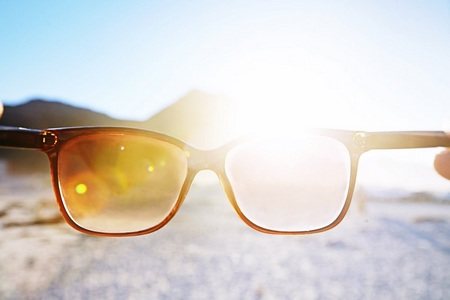
You can enhance the therapeutic effect of the main treatment using folk remedies. Some plants and other natural components have proven themselves in the treatment of ophthalmic pathologies accompanied by increased sensitivity of the eyes to bright light.
You can prepare the following drops:
- take eyebright erecta in a volume of 1 tsp. and water in the amount of 200 ml;
- the grass is poured with water, put on fire, brought to a boil;
- set aside to infuse for 3 hours;
- filter;
- Instill 3 drops into the affected eye before bedtime.
The temperature of the product used should be room temperature.
A lifesaver for eye diseases is sea buckthorn oil. However, it is not recommended to treat pathologies of the visual organ with this remedy without consulting a doctor.
Prevention
Preventive measures that will help prevent diseases that cause a phobia of light in children, and some measures will reduce discomfort and remove the causes of reactions to light:
- Children are not recommended to sit for a long time; this affects the health of their eyes, memory and attention. Rest and normal sleep will help avoid eye strain;
- Taking a seasonal vitamin complex will prevent respiratory diseases;
- A balanced diet and daily walks in the fresh air will increase the body’s resistance to infections and strengthen the immune system;
- Teach your child to maintain personal hygiene, use a separate towel, separate dishes - this will prevent conjunctivitis and acute respiratory infections
- Teach how to do eye exercises while reading a book, writing, embroidering or drawing.
- Interesting read:
A baby who remembers prevention will not be afraid of light and will be able to remain healthy.
Photophobia is the increased sensitivity of the visual organs to bright light. The cause of photophobia of the eyes can be both illness and prolonged exposure of a person in a room with no lighting. Damage may also occur due to the use of certain medications.
. Most often, a noticeable dilation of the pupils is observed, which refers to the reason for the sun's rays hitting the retina.
The oculomotor nerve is responsible for regulating pupil size
, thereby ensuring normal vision of surrounding objects at different degrees of illumination around. The entry of light through the refractive system into the retina is limited by the sympathetic and parasympathetic systems. The action of the first can lead to a noticeable dilation of the pupil, and the second to its narrowing. In a dark room, the pupil begins to increase in diameter, and in light it becomes smaller.
Photophobia is a sign that too much light
, which negatively affects the nervous system, causing the pupil to react with irritation.
Bright rays can provoke headaches
, epilepsy attacks, and other negative feelings.
Causes of photophobia:
- development of a migraine attack, increased level of intracranial pressure in epilepsy, hypertension, eclampsia in pregnant women;
- alcohol intoxication, drug intoxication, hangover;
- exposure to medications that significantly dilate the pupil;
- pathologies in the central nervous system due to traumatic brain injuries, tumors, neuroinfections, strokes and multiple sclerosis;
- allergic infections and respiratory diseases;
- albinism;
- eye diseases: conjunctiva, iris or cornea;
- pathology in the circular muscle, which narrows the pupil after injuries and various tumors.
This list is far from complete; there are a large number of diseases
, which cause photophobia.
Photophobia is more typical for attacks of epilepsy, traumatic brain injuries, encephalitis and other diseases that occur along with cerebral edema, eye damage and injuries that develop intolerance to bright sunlight
.
Main symptoms of photophobia
Sunlight or other too bright light sources can cause pain in the head and eyes. , seizures may develop
. Photophobia of the eyes may occur along with symptoms such as:
- itching of the conjunctiva;
- lacrimation;
- dizziness and rapid heartbeat;
- deterioration of visual acuity, white spots when looking into the distance;
- the process of salivation, the development of epilepsy with foam.
With traumatic brain injury, epilepsy or eclampsia, seizures
, which occur due to sunlight, odors and sharp sounds emanating from the external environment.
Photophobia and lacrimation
The development of photophobia and lacrimation may indicate the presence of a special lesion of the lacrimal glands and lacrimal ducts. , the sensitivity index increases
to the light, and lacrimation increases in the wind or in the cold. If such symptoms are combined, this indicates the presence of the following diseases.
Mechanical injury
If there is an eye injury, the person may complain of a feeling that a foreign body has entered the eye or that a strong blow
, chemical solutions (soap or shampoo) may also penetrate into the eye. In this case there is:
- constriction of the pupil;
- severe lacrimation;
- when looking at nearby objects, blurriness or a veil appears before the eyes;
- Pain in the eyes;
- high sensitivity to light.
All these symptoms can be found in the damaged eye.
Symptoms
Photosensitivity can affect one or both eyes. In this case, the following symptoms are observed:
- deterioration of visual acuity;
- feeling of sand in the eyes;
- blurred outlines of objects;
- redness and swelling of the mucous membranes;
- abnormal pupil dilation;
- paroxysmal headache;
- profuse lacrimation.
When a bright source of light appears, patients suffering from photophobia reflexively close their eyes or cover them with their hands.
As mentioned earlier, in most cases, photophobia is a sign of the development of visual pathologies. The following signs indicate the presence of diseases of an ophthalmological nature:
- prolonged redness of the whites of the eyes;
- swelling of the eyelids;
- suppuration in the eye area.
In order to accurately determine the nature and cause of the disease, it is necessary to undergo an ophthalmological examination. The disease cannot be eliminated at home. How exophthalmos manifests itself can be found in the article.
Deformation of the cornea of the eye
The process of inflammation of the membrane of the eye, or keratitis, which is of infectious (including herpetic) or allergic origin, retinal burn, erosion or ulcers. All this provokes similar symptoms, so it is difficult to distinguish the exact cause
diseases can only be diagnosed by a professional ophthalmologist after a thorough examination of the patient’s visual organ:
- redness of the sclera of the eyes;
- deterioration of visual acuity;
- a decrease in the transparency of the cornea (there is a film of varying degrees of turbidity, including the development of a porcelain film);
- the presence of a foreign body is felt under the eyelid;
- an involuntary process of closing the eyelids occurs;
- suppuration;
- lacrimation;
- photophobia;
- painful sensations in the eyes, pain after an ulcer or burn of the cornea is considered especially pronounced.
The disease begins acutely and can last for a long time, resulting in the formation of a cataract and blindness in the eye.
Symptoms in this case are almost always unilateral. Bilateral lesions in most cases are formed in the presence of an autoimmune disorder
in the visual organ.
Development of conjunctivitis
Acute conjunctivitis begins with severe pain and stinging in the eyes. The membranes of the eyes begin to become very red and small hemorrhages may begin in some places. Due to inflammation, pus, mucus, and tears begin to separate from the conjunctival sac. In addition, the patient’s condition begins to deteriorate significantly: general malaise, headaches occur, and the temperature level
bodies.
Herpetic diseases of the trigeminal nerve
With this disease there are:
- prodromal phenomena in the body: increased body temperature, malaise, chills, headache;
- a feeling of discomfort begins to arise near the eye due to severe itching, boring, deep pain;
- after this, the skin in the affected area begins to redden, swell and hurt;
- then bubbles form on the surface of the skin, which are completely filled with transparent exudate;
- redness and watery eyes due to damage;
- upon completion of healing, which can be accelerated with the help of Acyclovir ointment, crusts begin to actively form at the site of the rash, which scar and then leave severe defects;
- Once healing is complete, the pain begins to disappear, but watery eyes may continue to persist for a long time.
ARVI and influenza
Such diseases are characterized not only by photophobia, but also by increased lacrimation of the eyes. There is also a significant increase in body temperature, cough and runny nose. Influenza is also characterized by the presence of headaches in the muscles and bones, and diseases in the eyeballs when changing the direction of gaze.
Allergic photophobia
Snow and electric ophthalmia
Such damage to the peripheral analyzer occurs after prolonged exposure to ultraviolet radiation from the sun reflected by snow. As a result, characteristic redness of the sclera, photophobia and lacrimation are formed.
Diagnosis and causes
Only a doctor can determine which disease symptom is photophobia. It is recommended to visit an ophthalmologist if signs of photophobia persist for 2 or more days. First of all, studies are carried out to determine the condition of the visual organ: diagnostics of the cornea, ophthalmoscopy, etc.
If the results of ophthalmological diagnostics prove that there are no disorders in the visual organ, the patient is referred for consultation to a neurologist or neuropathologist.
An MRI or computed tomography scan of the cerebral and cervical spine may be necessary. In some cases, an ultrasound analysis of the thyroid gland is prescribed.
Clinical manifestations that are a reason for urgent consultation with a doctor:
- constant and prolonged increase in lacrimation;
- pain in the eyes that occurs even in low light;
- fog in the eyes when exposed to a light source;
- headache and dizziness due to photophobia.
You should consult an ophthalmologist if you need to wear sunglasses or squint even indoors.
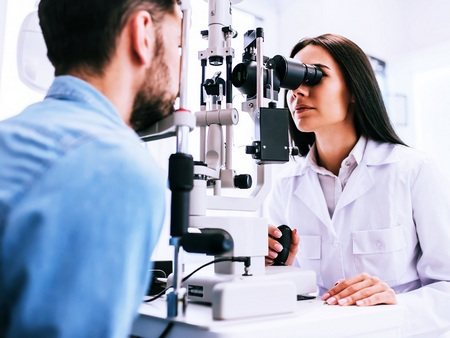
Diseases and drugs that cause complications
Swelling of the brain due to compression of the ventricles by numerous tumors can lead to disruption of the oculomotor nerve nucleus
. The accumulation of large amounts of fluid in the cavity (ventricles) leads to disruption of the functioning of the human central nervous system, including damage to the third pair of cranial nerves.
- An increased level of intracranial pressure occurs with hypertension, diseases of the kidneys, and heart due to the accumulation of fluid inside the body. Excess fluid begins to be released through the choroid plexuses at the bottom of the lateral ventricles. Meningitis, tick-borne encephalitis, influenza infection - all this can result in edema.
- Eclampsia in a pregnant woman occurs as a result of renal failure, as a complication of gestosis. Such a lesion develops epileptic seizures, which are preceded by poor sensitivity to light.
- When the body is intoxicated or when there is a feeling of fear, the sympathetic nervous system begins to work actively, which as a result leads to a high level of photosensitivity. People with mental illness have a fear of bright lights, also called heliphobia.
- Albinism is a genetic disease described by disturbances in the synthesis of melanin, which protects the retina from exposure to too much bright light and sunlight. With the development of such a pathology, the child develops a fear of sunlight.
- The sensitivity of one eye can increase significantly when the apex of the lung of the same name is affected by tuberculosis. In this case, the patient experiences dilated pupils, which leads to photophobia.
The effect of medications can provoke the development of increased photosensitivity. These include medications such as:
- Doxycycline;
- Salicylates;
- Anticholinergics: Bellasthesin, Atropine, Metacin, Scopolamine, Platyphylline, Amitriptyline.
Atropine is used to prepare the eye for examination. This process leads to mydriasis - dilation of the pupil. As a result, a large number of sunlight passes through it and a persistent fear of the sun and sunlight is formed.
Diagnosis of the disease and its prevention
To exclude all organic brain injuries (intracranial hematomas, tumors and hydrocephalus), the patient uses MRI. If you suspect complications when bearing a child, it is important to donate blood for a biochemical test (urea and creatine) and urine, in which protein can often be detected, which indicates disturbances in the normal functioning of the kidneys.
The electroencephalogram is very important for assessing the rate of excitation of the cerebral cortex, determining the location of the ectopic lesion that causes epileptic seizures and fear of light. If a doctor diagnoses heleophobia, the patient visits a psychiatrist.
When conducting diagnostics, it is very important to exclude alcohol intoxication and drugs, as well as conduct tests for the presence of such substances in the patient’s blood.
There is no need to suffer from bright daylight at all before going to the doctor. To alleviate your general condition, you need to purchase special polarized sunglasses that will help reduce the amount of ultraviolet radiation reaching the retina. You also need:
- reduce the number of hours per day working at the computer;
- stop rubbing your eyes too much;
- use Vidixic drops, which are considered a good means of artificial tears;
- if there is purulent discharge in the eyes, it is best to use special drops with antibiotics or antiseptics Tobradex, Okomistin, chloramphenicol drops. With all this, the attending physician must carefully examine the patient, since purulent processes can also affect the deeper layers of the eye, to which the local agent simply will not reach;
- If photophobia appears due to a burn, bruise or injury to the eye, then the patient should be immediately provided with ophthalmological care. First, you should drip the eyeball with drops containing an antiseptic effect, and apply sterile gauze to the eye.
There is no need to wait long before seeking help from a treating specialist, otherwise such a seemingly insignificant reason can provoke the development of a malignant tumor in the brain, which will begin to progress rapidly.
Attention, TODAY only!
Photophobia is a disorder in which a person experiences increased sensitivity to bright light. Another name is photophobia. The cause can be many diseases of the organs of vision. Scientists have found that people with light eye color are more likely to be affected by photophobia. In advanced cases, complete intolerance to light is observed. What diseases cause photophobia?
Photophobia - symptoms. With photophobia, a person reacts painfully to bright light sources: there is acute pain in the eyes, redness, irritation of the mucous membrane, a desire to squint, to turn away from the light source. Headache is a symptom accompanying photophobia. The thing is that the nerve endings of the retina are excessively sensitive, so at the slightest disturbance in the functions of the retina, photophobia of the eyes may occur.
Photophobia of the eyes - causes:
- Inflammatory diseases - conjunctivitis, keratitis. In this case, the eye tries to protect itself and maintain clarity of vision.
- Various eye injuries - sunburn, incorrectly selected lenses or glasses, curvature and ulcers of the cornea, retinal detachment.
- Heredity.
- Congenital differences in the structure of the eyes and body (albinos).
- Light eye color (the amount of pigment that protects the retina from light is very small).
- Various nervous diseases (meningitis, frequent migraines).
- Infectious diseases (measles, rabies, rubella).
- Poisoning with various toxic substances (mercury).
Causes also include adverse reactions to medications (Belladonna, furosemide, tetracycline, doxycycline, quinine). Under the influence of drugs that constrict the pupil, the retina is exposed to direct sunlight. Entry of a foreign body into the retina of the eye. In this case, photophobia is observed only in one eye. Environmental factors - excessive exposure to ultraviolet radiation on the eyes (looking at the sun or welding). Spending a long time in front of the monitor, fatigue and overwork, frequent depression and stress.
Photophobia is a symptom of the disease
Heliophobia is a fear of sunlight, a mental illness that has nothing to do with eye function. Fear of sunlight is usually associated with fear of other diseases. For example, such as skin cancer, sunburn, eye diseases that cause photophobia. Another similar disease is Gunther's disease. In this case, photophobia is just a symptom in which there is a fear of getting sunburn.
A child may develop photophobia due to an insufficient amount of melanin in the body or congenital defects. Children often stare at welding for a long time, which contributes to the occurrence of a disease such as snow ophthalmia. Insomnia, stressful situations, loss of appetite, fatigue, tachycardia, increased sweating - all this affects the quality of a child's vision.
Another cause of photophobia can be paralysis of the oculomotor nerve. With this disease, the child’s health is not impaired in any way, but the eyelid is drooping and the pupil is greatly dilated. Because of this, the development of photophobia begins.
Thyroid dysfunction is one of the causes of photophobia. At the first suspicion, consult an ophthalmologist. He will prescribe a number of procedures with the help of which he will establish an accurate diagnosis and treatment.
List of procedures to determine the source of the symptom:
- Ultrasound of the thyroid gland.
- Ophthalmic procedure.
- EEG (electroencephalography) is a procedure that examines brain activity.
- Test showing thyroid hormone levels.
Preventive actions
In essence, all treatment of Gunther's disease is one big prevention. In addition, the possibility of consanguineous marriages will have to be excluded. After all, it is the hereditary factor, enhanced by the birth disease, that becomes the cause of the development of the disease.
A prerequisite for prevention is constant monitoring by a doctor - he will be able to advise something if the condition worsens. Constant exposure to the sun will also have to be avoided.
Parents who suspect they are carriers of this gene should undergo the necessary examinations before planning a pregnancy. And if there is a positive result, it’s good to think about the topic of potential pregnancy, because the risk of passing on a broken gene is quite high.
Gunther's disease is one of the most mysterious diseases that turns the life of a person with this pathology into a complete nightmare. But even despite all the difficulties, you should not ignore medical recommendations. After all, with their help you can significantly alleviate the patient’s condition.
How to avoid photophobia?
Before trying to get rid of photophobia on your own, consult your doctor. Photophobia is not a separate disease, but only a symptom. This is why it is necessary to consult an ophthalmologist. He will conduct a thorough examination, find out the cause of the symptom, make a diagnosis and prescribe treatment.
Further treatment will depend on the cause of photophobia. For example, if any viral disease occurs, antiviral and antibacterial therapy will be prescribed. After final recovery, vision will return to normal.
However, there are small methods of self-prevention. It will help you reduce the unpleasant sensations from bright light, avoid redness and irritation of the mucous membrane of the eye. In some cases, photophobia has nothing to do with the appearance of diseases and disorders of the visual organs. In this case, you should buy dark sunglasses. Be sure to wear them on a bright sunny day. Glasses must have protective properties against ultraviolet rays.
If photophobia is caused by taking any medications, you should consult your doctor about changing medications.
Using antiseptic eye drops. The drops should have anti-inflammatory properties and soothe the mucous membrane of the eye. Wear special contact lenses or glasses that block sunlight. Avoid bright light sources. These small tips will help make life easier for people with photophobia.
Photophobia is not a disease, but just a symptom. Occurs due to the effects of various diseases, disorders in the function of the organs of vision. Symptoms of photophobia are redness of the eyes, dilated pupils, tearfulness, irritation of the mucous membrane, frequent blinking, avoidance of bright light sources. To alleviate the symptoms of photophobia, you need to purchase sunglasses with protection from direct ultraviolet rays, and use antiseptic eye medications aimed at relieving pain and removing inflammation and redness.
This disease manifests itself as discomfort that occurs from the light of the sun or an ordinary lamp. A person suffering from photophobia cannot look at the light, constantly experiences pain and burning in the eyes, the eyes begin to water, all this can be accompanied by a headache. Photophobia has nothing to do with the normal reaction of the human eye to light of increased brightness, which manifests itself as a short-term blurred vision. Photophobia manifests itself even in normal light brightness. Photophobia is not a disease, but a symptom that speaks of pathological processes occurring in the eyes or other organs of the human body. If you notice such signs, you should immediately consult a doctor.
By secret
- Incredible... You can cure your eyes without surgery!
- This time.
- No trips to the doctors!
- That's two.
- In less than a month!
- That's three.
Follow the link and find out how our subscribers do it!
What does photophobia mean? What are the causes and symptoms of this disease? And, most importantly, what means of eliminating the problem are most effective?
In medicine, the term photophobia (photophobia)
indicates a state of hypersensitivity and intolerance by the eyes to light, both natural and artificial. Of course, photophobia is especially noticeable when exposed to bright light sources.
Photophobia cannot be considered as a real pathology. As a rule, it is only a consequence of other pathological processes occurring in the body.
Causes of photophobia
Photophobia occurs when the nerve endings in the eyeball are hypersensitive to light.
The reasons for its appearance can be very different. Many inflammatory processes occurring in the front of the eye cause similar symptoms. These are, for example, conjunctivitis, corneal injuries, keratitis and others. In these cases, the eye is protected in a similar way, trying to preserve vision. Some medications can affect the photosensitivity of the eyes, such as tetracycline, quinine, furosemide, belladonna, etc. If unpleasant symptoms are observed in only one eye, this may mean that a foreign body has entered the cornea.
Photophobia can be triggered by excessive ultraviolet radiation, if you look at the sun for a long time or at sparks that appear during welding work. A tumor in the brain can also cause intolerance to light, even the most ordinary brightness. Photophobia can accompany attacks of migraine and glaucoma. Patients suffering from measles, allergic rhinitis, rabies, botulism and some other diseases also note increased sensitivity to light. Congenital photophobia often occurs in albino people. Depression, chronic fatigue, and poisoning with certain substances also provoke photophobia. Sitting in front of a computer or TV for too long, or wearing lenses for a long time often lead to photophobia.
What to do if you have photophobia
Due to the complex and varied etiology of the disorder, it is difficult to give an unambiguous treatment protocol, and often completely impossible.
The first step is, of course, a correct diagnosis, that is, establishing the exact cause causing sensitivity to light.
If the cause is non-pathological, it is necessary to determine the source of the problem: taking medications or drugs that cause pupil dilation.
If the cause is pathological, then we can try to keep the symptoms under control through a range of remedies, which we list below:
- Supplements. Most suitable are those based on lutein and zeaxanthin. Due to their antioxidant properties, such supplements have a protective function for vision.
- Natural remedies. Include the use of drops and compresses obtained from certain herbal products, namely chamomile, artichoke, mallow and butterbur.
- Sunglasses . The easiest way to keep photophobia under control. Note that brown filters are the most effective.
Treatment of photophobia
For treatment to be effective, it is necessary to identify the disease that provoked the appearance of photophobia.
Depending on the disease that caused the increased sensitivity, the doctor will prescribe treatment, after which photophobia will disappear. During treatment, the patient must follow certain rules of behavior that will make his life much easier. In sunny weather, you cannot go outside without special sunglasses that have 100% UV protection. If photophobia is caused by taking any medications, you should consult your doctor about the possible replacement of medications with others.
If photophobia is a temporary phenomenon, then eye drops with antiseptic, anti-inflammatory and moisturizing effects will help. In the case of congenital or disease-induced photophobia that cannot be cured, a person can alleviate his condition by constantly wearing sunglasses or lenses that allow less light to enter the eyes.
It might be useful to read:
- The border of the anterior and posterior mediastinum;
- Study of the most common mutations of the CFTR gene (cystic fibrosis);
- Laryngoscopy: what it is, features of examination and preparation for it;
- Herpetic meningoencephalitis consequences of Meningo encephalitis;
- Malignant tumors of the major duodenal papilla;
- What is the method of liver research proposed by Kurlov? ;
- Anemia with mixed type of hemolysis;
- What does high voltage ECG mean?
Treatment
Symptom therapy is prescribed after determining the causes of the pathology. Doctors advise patients to follow simple rules:
- on sunny days do not leave the house without sunglasses;
- use eye drops;
- During migraine attacks, it is advisable for the patient to go to a dark place.
Timely treatment of photophobia and the causes of its occurrence contributes to the rapid relief of this symptom.
However, quite often the symptom is not formed against the background of any disease, but is congenital. In this case, doctors recommend adhering to the above rules.
An effective remedy for restoring vision without surgery or doctors, recommended by our readers!
Often, when leaving a dark room on a sunny day, tears begin to flow from your eyes. I really want to close them with my hands. This is the weakest manifestation of photophobia. In more severe pathologies, pain, pain, and lacrimation occur at the slightest ray of light. Photophobia is one of the most common ophthalmological diseases.

